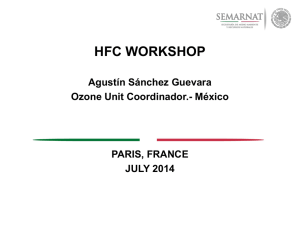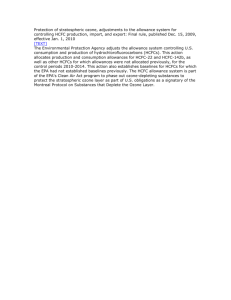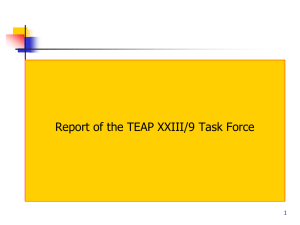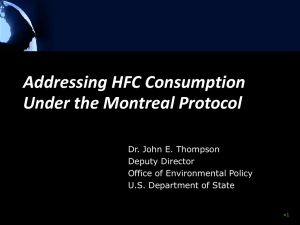REPORT OF THE EXECUTIVE COMMITTEE OF
advertisement
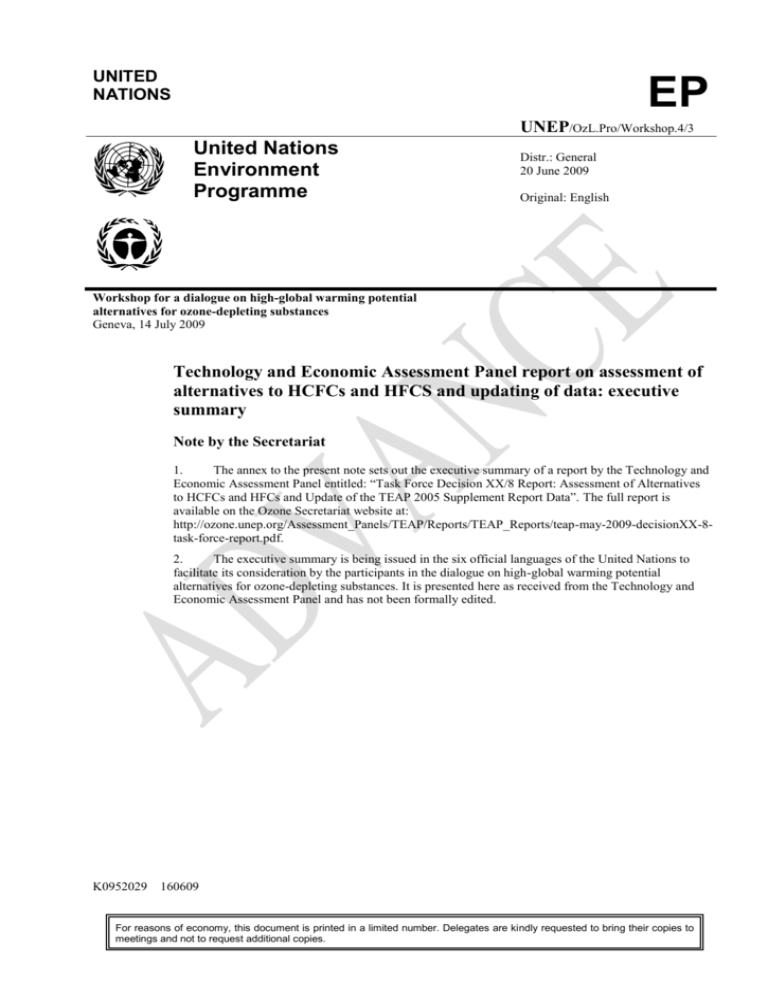
UNITED NATIONS EP UNEP/OzL.Pro/Workshop.4/3 United Nations Environment Programme Distr.: General 20 June 2009 Original: English Workshop for a dialogue on high-global warming potential alternatives for ozone-depleting substances Geneva, 14 July 2009 Technology and Economic Assessment Panel report on assessment of alternatives to HCFCs and HFCS and updating of data: executive summary Note by the Secretariat 1. The annex to the present note sets out the executive summary of a report by the Technology and Economic Assessment Panel entitled: “Task Force Decision XX/8 Report: Assessment of Alternatives to HCFCs and HFCs and Update of the TEAP 2005 Supplement Report Data”. The full report is available on the Ozone Secretariat website at: http://ozone.unep.org/Assessment_Panels/TEAP/Reports/TEAP_Reports/teap-may-2009-decisionXX-8task-force-report.pdf. 2. The executive summary is being issued in the six official languages of the United Nations to facilitate its consideration by the participants in the dialogue on high-global warming potential alternatives for ozone-depleting substances. It is presented here as received from the Technology and Economic Assessment Panel and has not been formally edited. K0952029 160609 For reasons of economy, this document is printed in a limited number. Delegates are kindly requested to bring their copies to meetings and not to request additional copies. UNEP/OzL.Pro/Workshop.4/3 I. Executive Summary 3. This report responds to the request by Parties in Decision XX/8, paragraph 1. It describes the alternatives to HCFCs and HFCs as well as current market penetration for all relevant sectors and subsectors, including refrigeration and air conditioning, foams, fire protection, solvents and inhaled therapy. It presents updated data (compared to 2005) on ODS and HFC banks and emissions for fire protection, foams, and refrigeration and air conditioning. 4. Approximately 100 million domestic refrigerators and freezers are produced annually. An estimated 1500 to 1800 million units are now installed globally. Conversion of all new production of domestic refrigerators and freezers from ozone-depleting refrigerants is complete; non-Article 5 countries completed conversions by 1996, Article 5 countries by 2008. 63 percent of current new production employs HFC-134a refrigerant and 35.5 percent employ hydrocarbon refrigerants, either HC-600a or blends of HC-600a and HC-290. Two industry dynamics of interest are second-generation migration from HFC-134a to HC-600a and preliminary discussions on using unsaturated HFCs (sometimes referred to as HFOs)1 to displace HFC-134a usage. Each of these dynamics is motivated by global warming considerations. 5. Conversions from HFC-134a to HC-600a began several years ago in Japan. This has progressed to include the majority of new refrigerator production in Japan. A major U.S. manufacturer recently announced its intent to introduce refrigerators using HC-600a refrigerant. Codes and standards modifications and approvals are currently in process and commercial introduction is expected in 2009. Theoretical assessment of the performance of unsaturated HFCs indicates these have the potential for comparable efficiency to HFC-134a in domestic refrigerators. Since long-term reliability expectations for domestic refrigerators are significantly more demanding than for the automotive use for which these HFCs are currently being proposed, numerous application criteria need to be assessed before these refrigerants can be considered viable alternatives. 6. Not-In-Kind (NIK) refrigeration technologies continue to be pursued for applications with unique drivers such as portability or no access to electrical distribution networks. No identified technology is cost or efficiency competitive with conventional vapour-compression technology for mass-produced domestic refrigeration equipment. 7. Field service procedures typically use originally specified refrigerants. Final ODS refrigerant production units in developed countries are now approaching the end of their life cycle and service demand for the legacy refrigerants is vanishing. Service demand for these legacy refrigerants in developing countries is expected to remain strong for at least a decade as a result of the delayed conversion of new production to non-ODS refrigerant. Successful conversion of existing units to alternative refrigerants has been limited. Informed technical assessment is essential to ensure that product safety and performance are retained. Acceptance of several reduced ODS blends for service has been good where regulations promote their use. Required product modifications for conversion to flammable refrigerants are directly dependent on the original product configuration. 8. Relative energy efficiency provides a direct nexus to relative global warming behaviour for domestic refrigeration products. Energy labelling and energy regulations are widely used to promote improved product energy efficiency. Options to cost-effectively improve product energy efficiency have been thoroughly validated, but require capital funds to implement. Additional options with reduced economic justification have also been validated. 9. In commercial refrigeration, the number of supermarkets world-wide is estimated at 530,000 in 2006 (with sales areas varying from 500 to 20,000 m2). The population of vending machines, stand-alone equipment, and condensing units are estimated at 20, 32, and 34 million units, respectively. In 2006, the refrigerant bank was estimated at 547,000 tonnes and it is split over the refrigerant types CFCs (30%), HCFCs (55%), HFCs (15%) and others; hydrocarbons or CO2 are still representing a non significant share in this sector. Due to high refrigerant leakage rates, commercial refrigeration causes 1 Newly developed (low GWP) unsaturated HFCs are normally defined by the chemical manufacturers as “HFOs” (hydro-fluoro-olefins), derived from “olefins”, the historic name for unsaturated hydrocarbons. This in order to separate them from the common “HFCs”. Nomenclature issues as well as the reporting of emissions of HFC chemicals are further addressed in Annex 2 of the XX/8 Task Force report. 2 UNEP/OzL.Pro/Workshop/4/3 more refrigerant emissions in terms of CO2 equivalent (considering the GWP of the CFC and HCFC refrigerants) than any other refrigeration application. 10. For stand-alone equipment, HFC-134a fulfils the technical constraints in terms of reliability and energy performance. Should the GWP of HFC-134a lead to unacceptable emissions, then the options are (1) to require a very stringent policy for recovery at end of life or (2) the use of refrigerants such as HC-600a or HC-290 may be viable solutions. 11. The use of HCFC-22 in many centralised systems lasted until 2008 in developed countries and no refrigerant has been considered a unique solution to replace HCFC-22. Intermediate HFC blends such as R-422A or R-427A have not gained significant market shares, even if they facilitate a HCFC-22 retrofit. Moreover, the future of a high GWP refrigerant blend such as R-404A is seen as uncertain, especially in Europe. Currently, several hundreds of new indirect systems have been installed in Europe using CO2 at the low-temperature level either as a heat transfer fluid or as a refrigerant. For the medium-temperature level, where the larger portion of the refrigerant charge is present, the main choice for new systems still is R-404A, however, hydrocarbons or CO2 are applied in several European countries. The refrigerants of the future are still under evaluation in this commercial refrigeration sector because there is not one single candidate that can be used safely for all climatic conditions and all temperature levels, while at the same time also having a low GWP, high energy efficiency and be safe. 12. In large refrigeration systems, particularly in the industrial sector, ammonia has been much more widely used than in other sectors, and the HCFCs and HFCs are generally restricted in use to applications where ammonia is not suitable, usually due to concerns about toxicity. In these limited applications it has been relatively easy for designers to adapt to other “natural” refrigerants”; in particular carbon dioxide, usually in cascade with a reduced charge HFC system, ammonia or a hydrocarbon. Industrial systems usually require a bespoke design whichever refrigerant is used and hence the complexity and additional effort required to implement novel solutions are less of an impediment than in the commercial or domestic sectors. 13. On a global basis, air-cooled air conditioners and heat pumps ranging in size from 2 to 420 kW comprise a vast majority of the air conditioning market below 1,500 kW capacity. Nearly all air-cooled air conditioners and heat pumps manufactured prior to 2000 used HCFC-22 as their working fluid. 14. In the non-Article 5 countries, HFC refrigerants have been the dominant replacement for HCFC-22 in all categories of unitary air conditioners. The most widely used replacement is R-410A, a blend of two HFC refrigerants. The next most widely used replacement is R-407C. Hydrocarbons have been used in some very low charge applications; including lower capacity portable room units and split system air conditioners. 15. The transition away from HCFC-22 is nearly complete or well underway in most developed countries. The phase-out of HCFC-22 in the manufacturing of new products in the EU occurred in 2004. The phase-out in North America and Japan is to be completed in 2010. Most Article 5 countries are continuing to utilise HCFC-22 as the predominant refrigerant in unitary air conditioning applications. With the recently approved adjustment to the Montreal Protocol, developing countries are expected to start to increase actions regarding the HCFC refrigerant replacement, including the elaboration of HCFC Phase-out Management Plans (HPMP) supported by the Multilateral Fund of the Montreal Protocol. 16. Currently, the HFC refrigerant blends R-410A and R-407C are the most applied replacements for HCFC-22. At this moment in time, the industry is in the very early stages of the process of developing and applying low GWP alternatives for these refrigerants in Unitary Air Conditioning applications. There are several alternatives that are showing promise including hydrocarbons, CO 2 and new low GWP (unsaturated) HFCs. However, the development of products with these options is expected to require significant additional research and development. Therefore, the responsible use of HFCs is the near term solution to achieve the best Life Cycle Climate Performance (LCCP) for unitary air conditioners. 17. For chillers with reciprocating, screw, and scroll compressors, HCFC-22 is being succeeded in newly-designed equipment by HFC-134a or R-410A. R-407C has been used as a transition refrigerant for equipment designed for HCFC-22. Some chillers are available with R-717 (ammonia) or hydrocarbon refrigerants (HC-290 or HC-1270). Such chillers are manufactured in small quantities compared to HFC chillers of similar capacity and require attention to safety codes and regulations because of flammability concerns and, in the case of R-717, toxicity concerns. 3 UNEP/OzL.Pro/Workshop.4/3 18. Few chillers with centrifugal compressors employed HCFC-22. When CFC refrigerants were phased out, HFC-134a and HCFC-123 were the refrigerants used in this class of equipment. These refrigerants continue to be used in new equipment. R-717 is not suitable for use in centrifugal chillers. Hydrocarbon refrigerants are so far mainly used in centrifugal chillers in industrial process applications. 19. Chiller refrigerants proposed as alternatives to HFCs include R-717, hydrocarbons, carbon dioxide, and new unsaturated HFCs such as HFC-1234yf. R-744 (carbon dioxide) has rather poor energy efficiency for chiller applications in warmer and hot climates. HFC-1234yf and similar low GWP refrigerants are too recent to allow assessment of their suitability for use in chillers. Therefore, responsible use of HFCs in the case of HFC chillersis the near term solution to achieve the best Life Cycle Climate Performance (LCCP). 20. For highly specialized chiller applications such as military shipboard and submarine use, unique requirements for toxicity and flammability limit the available options to either high GWP HFCs, replacements such as HFC-134a and HFC-236fa, or the ozone depleting substances HCFC-22 or CFC-114. 21. For mobile air conditioning systems there are basically three refrigerant options still under consideration: R-744, HFC-152a and HFC-1234yf. They have GWPs below 150 and can achieve fuel efficiency comparable to existing HFC-134a systems. Hence, adoption of either would provide similar environmental benefit. The decision of which refrigerant to choose would have to be made based on other considerations, such as regulatory approval, cost, system reliability, safety, heat pump capability, suitability for hybrid electric vehicles, and servicing. Industry work is focused mainly on HFC-1234yf and R-744 and the choice must be made soon to meet the EU’s mobile air conditioning directive. Regulations are also under development in the USA that will encourage the use of a new low GWP refrigerant in the USA starting in 2012. 22. There is an industry preference to choose one refrigerant for vehicles sold in all markets worldwide but given the number of potential replacement options it appears to be likely that there will be at least two refrigerants in the global automotive marketplace in the near future, in addition to the residual use of CFC-12 and HFC-134a as global phase-outs continue. 23. The main polyurethane (PU) sectors currently using HFCs are rigid insulating foams and flexible integral skin foams. Hydrocarbon (HC) technology has proven to be a suitable option to HFCs for all polyurethane foam applications with the exception of spray where safety becomes a critical issue. Refining of HC technology has largely closed the gap in thermal performance with HFCs. Current HC technology is not economic to apply in small and medium enterprises because of the high equipment conversion cost to ensure safe use. Pre-blended or directly injected hydrocarbons may play a role for these enterprises but a rigorous safety evaluation will then be needed. 24. For PU integral skin foams, CO2 (water) or hydrocarbon technologies are well proven alternatives. Supercritical CO2 has been successfully introduced as an option for spray applications in Japan. 25. Methyl formate (with trade name Ecomate), and methylal are commercially available alternatives that require full performance validation, including foam physical properties and fire performance testing. Unsaturated HFCs are emerging as potential alternative blowing agents. The evaluation of their toxicity and environmental impact as well as foam properties performance still needs to be completed. Commercial supply is expected to take a minimum of 2 years, except for HFC-1234ze, which is already commercially available for one-component foams in the EU. 26. Foams compete with different types of materials in thermal insulation and other applications. Mineral fibre (including both glass fibre and rock fibre products) continues to be the largest single insulation type with cost being the primary driver for selection. 27. The demand for energy saving measures and materials is driving the growth of insulating XPS foams and significant capacity is already in place for these foams in China and elsewhere in Article 5 countries. 28. Non-Article 5 countries have virtually eliminated HCFCs in rigid insulating foams, particularly the European countries. In summary, instead of using HCFC-22 and -142b, HFCs, CO2 and/or water can be applied as blowing agents in the manufacture of XPS. 29. In Article 5 countries, HCFC-142b and/or HCFC 22 still are the preferred choices and growth in their use has been driven by the large number of XPS plants in operation in, for example, China, the Middle East and Eastern Europe. North American XPS board producers are still on course to phase out the use of HCFCs by the end of 2009. The alternatives of choice are likely to rely on combinations of 4 UNEP/OzL.Pro/Workshop/4/3 HFCs, CO2, hydrocarbons and water. In China, work is being carried out by the equipment suppliers to modify existing units to introduce CO2 into the extruder. Given the continuous growth of XPS foam in Article 5 countries and with the accelerated HCFC phase-out, demand and supply for HCFCs are likely to become pressing issues sooner rather than later. 30. Owing to the long lead times for testing, approval and market acceptance of new fire protection equipment types and agents, only minor changes in use patterns have occurred since publication of the Special Report on Ozone and Climate (SROC). The main driving force in the choice of fire protection systems still appears to be based on three main factors: (1) tradition, (2) market forces and (3) cost. Since the SROC, two new technologies have been developed in the fire protection area (i.e., technologies to suppress fires through the production of mainly nitrogen with water vapour). Both of these technologies are characterised as Not-In-Kind and may represent a growing trend within fire protection total flooding system research and development. It is too early to determine the pure market effect of the recently developed not-in-kind systems. Their impact may reach the broader halon market or traditional in-kind substitutes may well limit their impact to replacing only other not-in-kind alternatives. No additional truly new options are likely to be available in fire protection in time to have appreciable impact over the next 10 years. A possible singular exception is a potential halon 1211 replacement that had been under development some years back but was then abandoned. Since much of the developmental work has already been completed, the agent has the potential to have appreciable impact within 5 or so years from restarting developmental efforts. 31. For some applications in highly specialised fire protection requirements such as military, aerospace and low temperature oil and gas production, only the original halon or the replacement HCFC or HFC are available to meet the fire and explosion suppression requirements. 32. Unpublished data on the emissions of halon 1211 and 1301 for North Western Europe, using the methodology described by “Greally” in 2007, suggest that emissions of both halon 1211 and 1301 may have remained relatively constant or perhaps increased during the period when non-critical halon systems had to be removed from service and halons had to be properly disposed of, in accordance with European Regulation (EC) No. 2037/2000. For both halon 1301 and halon 1211 the estimated installed base within Europe could be somewhat larger than the quantities reported to the European Commission as contained within Critical Uses. 33. In solvent applications, most of the ODS solvents like 1,1,1-trichloroethane (TCA) and CFC113 have been in principle replaced by Not-In-Kind technologies. Therefore, HCFC and HFC (replacement) solvents are not belonging to the most important solvent sectors currently under development. It needs to be mentioned that HCFC-141b use as a solvent is still increasing in Article 5 countries, but this chemical is expected to be replaced by chlorinated (non MP controlled) solvents and other Not-In-Kind technologies in the near future, while applying appropriate safety considerations. HCFC-225 and some HFC solvents such as HFC-43-10mee, HFC-c447ef, HFC-245fa and HFC-365mfc have been used where non-ODS solvents were or are not available, in particular in solvent operations in non-Article 5 Parties. Some hydrofluoroethers (HFEs) could be replacement options for these HCFC and HFC solvents. However, there are a few specialty solvent applications that can still only be met with HCFC-225 (or 141b) or the original Class I ODS solvent (e.g., CFC-113). For example, the US Navy use of HCFC-225 (or HCFC-141b) to replace CFC-113 to clean shipboard oxygen producers. No other alternatives are available. 34. Inhaled therapy is essential for the treatment of patients with asthma and COPD and the numbers of inhalers used world-wide is increasing steeply. It is projected that metered does inhalers (MDIs) will use and emit ~7000 tonnes of HFCs (or 10,000 ktonnes CO2 equivalent) by the time the CFC transition will be completed by 2015. This will entail significant technology transfer to developing countries for local manufacture of affordable HFC MDIs, with financial support from the Multilateral Fund. However, local manufacturers in developing countries could switch to Dry Powder Inhaler (DPI) manufacture. DPIs are available for most inhaled drugs, and could replace the majority of propellant MDIs. Patients find them easy to use, and with local manufacture they are affordable. 35. In fire protection, banks of halons are expected to decrease much slower than was expected in the 2005 Supplement because the emission rates for halons are expected to be lower than predicted in the Supplement Report in 2005 (e.g., 50% lower in the year 2015). Emissions of HCFCs (and PFCs) are in the range of 100-130 ktonnes CO2 equivalent. Emissions of HFCs continue to grow in direct proportion to the increasing size of the bank of HFCs and are predicted to be about 4-6,000 ktonnes CO2 equivalent in the period 2015-2020 (for comparison purposes the emissions of HCFCs and HFCs in 5 UNEP/OzL.Pro/Workshop.4/3 refrigeration and air conditioning are both predicted in the 400-600,000 ktonnes CO2 equivalent range during the period 2015-2020). 36. In foam applications, the banks of CFCs are expected to diminish slowly to 6.75 Gtonnes CO2 equivalent in the period to 2020 but will still be the largest single bank in climate terms for the foreseeable future after that. The bank of HCFCs will largely stabilise in the period 2010 to 2020 with some shorter lifecycle applications (e.g. domestic refrigerators) being decommissioned in non-Article 5 countries while growth in bank size will continue in Article 5 regions. HFC banks are expected to grow to just under 1 million tonnes by 2020 unless pressure to move to lower-GWP solutions is brought to bear. 37. In contrast with the refrigeration and air conditioning sectors, emissions from foam banks vary between 1% and 3% of bank size annually depending on the maturity of the bank in question and the portfolio of applications covered. CFC emissions are expected to be around 1.25% of bank size in 2020, while HFC emissions will be running at about 3.1% annually at that time. 38. In refrigeration and air conditioning, the banks that are currently estimated for the year 2015 in a business as usual (BAU) scenario are slightly different from the ones estimated in the year 2005. They are lower, for HCFCs (10%) and HFCs (25%) in stationary air conditioning; they are also estimated slightly lower for mobile AC. This again influences the level of the emissions estimated for 2015 and beyond. In the BAU scenario, global emissions total about 820 ktonnes for all refrigeration and AC sectors for all chemicals in the year 2015, a level which equates to 1.4 Gtonnes CO2 equivalent. 39. If one compares the global banks (in the BAU scenario) between 2015 and 2020, the total HCFC bank is estimated to decrease, whereas the HFC bank is estimated to increase by about 30% in this five year period. A similar tendency can be observed in the emissions. HCFC emissions from the different subsectors generally decrease, with an average decrease estimated for all sectors of 7% between 2015 and 2020. Where it concerns the HFC emissions, growth is estimated in the BAU scenario to be between 4 and 63% in the different subsectors with a growth of 21% over all sectors. 40. In the BAU scenario, emissions for Article 5 countries would be about 500 ktonnes for all sectors in the year 2015, this being somewhat less than 0.8 Gtonnes CO 2 equivalent for 2015. This means that as early as 2015 more than 60% of the global total would come from Article 5 countries. If one compares the emissions between 2015 and 2020 in Article 5 countries, total HCFC emissions are estimated to level off (where there is estimated a sharp decrease in non-Article 5 countries). At the same time, the HFC emissions are estimated to increase by about 28% in this five year period (mainly in the domestic, industrial and stationary air conditioning sector). 41. In a MIT (mitigation) global scenario (using currently available techniques and alternatives in the best way possible), HCFC emissions from the different subsectors generally decrease, with an average decrease estimated for all sectors of 17% between 2015 and 2020 (compared to a 7% decrease in the BAU scenario for the same period). As regards HFC emissions, growth is estimated in the mitigation scenario between -16% and 50% in the different subsectors with a growth of 8% over all sectors (compared to a 20% growth in HFC emissions for the BAU scenario). Global Emissions total at 610 ktonnes for all refrigeration and AC sectors for all chemicals in the year 2015, a level that equates to 1.0 Gtonnes CO2 equivalent in the MIT scenario. This level is expected to decrease to 0.92 Gtonnes CO2 equivalent by 2020. 42. In the MIT scenario for Article 5 countries, HCFC emissions from the different subsectors are generally expected to decrease between 2015 and 2020 (+15% to -40% dependent on the subsector), with an average decrease estimated for all (HCFC) subsectors of 10%. Where it concerns HFC emissions, growth is estimated over the period 2015-2020 in the MIT scenario in several sectors, with a modest increase of about 16% in the mobile AC subsector between 2015 and 2020. Totalled over the different subsectors this yields an increase of 26-30% in HFC emissions (30% in tonnes and 26% in CO2 equivalent); for comparison, HFC emissions in Non-Article 5 countries are expected to remain virtually the same during 2015-2020. 43. Overall, however, total emissions in the MIT scenario in Article 5 countries are expected to decrease by about 5% between 2015 and 2020, with an increase in HFC emissions (25%). 44. With a significant market penetration of low GWP technologies, and good containment practices, it might well be that HFC emissions could stabilise in Article 5 countries in the 2020-2030 decade. This would be contrary to the growth sometimes considered as unavoidable for HFC emissions in Article 5 countries for the decades after 2020 (up to 2030-2040). It may be expected that this could result in a further decrease of total emissions (the sum of CFC, HCFC and HFC emissions) after 2020. 6 UNEP/OzL.Pro/Workshop/4/3 45. A more accurate estimate can be made in 4-5 years when the market penetration of different low GWP alternatives for various HCFC replacement technologies in the refrigeration and AC sectors will be more accurately known (in response to the accelerated HCFC phase-out schedule in the Article 5 countries, as well as to developments in non-Article 5 countries). 46. As a summary for HCFC and HFC banks and emissions for the period 2002-2020, the tables below highlight the numbers noted above for fire protection, foams and refrigeration and AC (in Mtonnes CO2 equivalent). They provide data for 2002 from the Supplement Report, the updated BAU and MIT scenario totals for 2015 and 2020 (which were derived in particular for the part describing the refrigeration and AC sectors), as well as the average of these BAU and MIT scenario data. Only Average BAU-MIT values have been used in the analysis presented below (which then particularly yields a higher emissions growth than in the MIT scenario itself). Foams data were included for HCFCs and HFCs, while the HFC emissions have been estimated for non-Article 5 and Article 5 countries on the basis of a 90-10% estimate, respectively. UPDATED 2009 BANKS in Mt CO2 equivalent year AVERAGE BAU-MIT 2002 2015 2020 MIT 2015 BAU 2015 MIT 2020 BAU 2020 HCFC HCFC HFC HFC nA5 A5 nA5 A5 2773 1063 986 86 1879 2257 3161 1112 1564 2258 4050 1551 1753 2257 3131 1097 2004 2256 3191 1127 1450 2256 3882 1574 1677 2260 4217 1527 HCFC HFC TOTAL WORLD WORLD WORLD 3836 1072 4908 4135 4273 8408 3822 5600 9422 4010 4228 8238 4260 4318 8578 3706 5456 9162 3937 5744 9681 AVERAGE BAU MIT 2002 2015 2020 MIT 2015 BAU 2015 MIT 2020 BAU 2020 UPDATED 2009 EMISSIONS in Mt CO2 equivalent year HCFC HCFC HFC HFC nA5 A5 nA5 A5 218 223 198 10 99 525 411 147 58 507 460 184 76 468 328 131 122 581 494 162 36 427 326 167 80 586 593 201 HCFC HFC TOTAL WORLD WORLD WORLD 441 208 649 624 558 1181 565 644 1208 544 459 1003 703 656 1359 463 493 956 666 794 1460 47. The growth in the size of the banks between 2002 and 2020 is virtually zero for HCFCs , however far larger for HFCs (growth by a factor of about five). There is not much difference between the MIT than in the BAU scenario where it relates to the bank sizes (less than 10% for both 2015 and 2020); this is different for emissions. 48. As can be seen in the table, the banks of HCFCs are expected to slightly decrease during 20152020, whereas banks of HFCs are forecast to further increase by about 30%. The total amount in banks in the world for all relevant sectors (i.e., refrigeration and AC, foams and fire protection) for HCFCs and HFCs are expected to increase by a factor of 2 between 2002 and 2020. 49. Both for HCFCs and HFCs the emissions are expected to increase between 2002 and 2020, with a substantial increase for HFCs . The global HCFC emissions are expected to slightly decrease (by about 10%) after 2015, whilst an increase in global HFC emissions is expected by 15-20% between 2015 and 2020). Part of this increase will be due to replacement of HCFCs with HFCs, while the remainder will be due to expansion of HFC use in certain sectors due to economic growth. 50. Total (i.e., the sum of HCFC and HFC) emissions are expected to increase in both non-Article 5 and Article 5 counties between 2002 and 2020 with a quite moderate increase in non-Article 5 countries and a much larger increase in Article 5 countries (by almost a factor of three). The growth is expected to be largest before 2015, with only a marginal global increase during the period 2015-2020.. For the average of the BAU and MIT scenario, observations related to emissions from Article 5 and nonArticle 5 countries for the period 2015-2020 are summarised as follows: (a) countries; No increase is expected in the sum of HCFC and HFC emissions in non-Article 5 7 UNEP/OzL.Pro/Workshop.4/3 (b) A small decrease is expected in HCFC emissions in Article 5 countries; and (c) HFC emissions in Article 5 countries are expected to increase by almost 30%. 51. Further reductions in the size of the emissions can be realised by increasing the use of low GWP substances compared to the forecast and through applying additional improved containment practices than so far anticipated. This tendency is clearly shown in the table in the MIT emissions where substantially lower values for both the years 2015 and 2020 are recorded. 52. It should be born in mind that these values are based upon the values in tonnes multiplied with the GWPs for the different chemicals from the Second IPCC Assessment Report. They would all be 10-20% higher if the GWP values would have been used as published in the IPCC Fourth Assessment Report (AR4 WG I). ––––––––––––––––––––––––– 8
